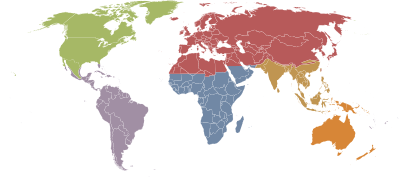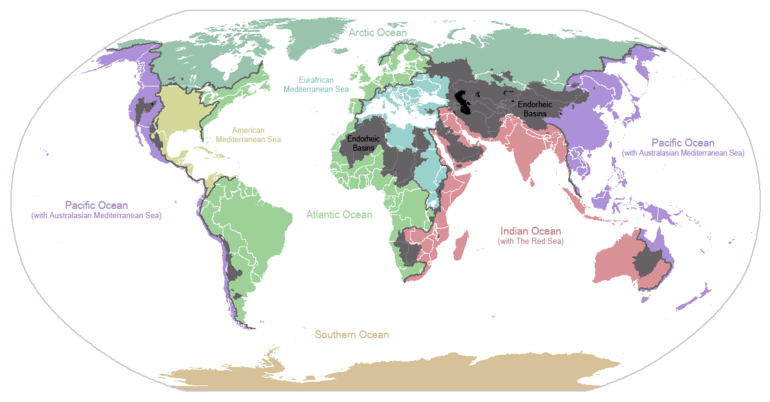Biogeographic realm
A biogeographic realm or ecozone is the broadest biogeographic division of Earth's land surface, based on distributional patterns of terrestrial organisms. They are subdivided into ecoregions, which are classified based on their biomes or habitat types.

The realms delineate the large areas of the Earth's surface within which organisms have been evolving in relative isolation over long periods of time, separated from one another by geographic features, such as oceans, broad deserts, or high mountain ranges, that constitute barriers to migration. As such, biogeographic realm designations are used to indicate general groupings of organisms based on their shared biogeography. Biogeographic realms correspond to the floristic kingdoms of botany or zoogeographic regions of zoology.
Biogeographic realms are characterized by the evolutionary history of the organisms they contain. They are distinct from biomes, also known as major habitat types, which are divisions of the Earth's surface based on life form, or the adaptation of animals, fungi, micro-organisms and plants to climatic, soil, and other conditions. Biomes are characterized by similar climax vegetation. Each realm may include a number of different biomes. A tropical moist broadleaf forest in Central America, for example, may be similar to one in New Guinea in its vegetation type and structure, climate, soils, etc., but these forests are inhabited by animals, fungi, micro-organisms and plants with very different evolutionary histories.
The patterns of distribution of living organisms in the world's biogeographic realms were shaped by the process of plate tectonics, which has redistributed the world's land masses over geological history.
Concept history
The "biogeographic realms" of Udvardy (1975) were defined based on taxonomic composition. The rank corresponds more or less to the floristic kingdoms and zoogeographic regions.
The usage of the term "ecozone" is more variable. It was used originally in stratigraphy (Vella 1962, Hedberg 1971). In Canadian literature, the term was used by Wiken (1986) in macro level land classification, with geographic criteria (see Ecozones of Canada) (Wicken 1986, Scott 1995). Later, Schültz (1988) would use it with ecological and physiognomical criteria, in a way similar to the concept of biome.
In the Global 200/WWF scheme (Olson & Dinerstein 1998), originally the term "biogeographic realm" in Udvardy sense was used. However, in a scheme of BBC (n.d.), it was replaced by the term "ecozone".
Terrestrial biogeographic realms
Udvardy (1975) biogeographic realms
WWF / Global 200 biogeographic realms (BBC "ecozones")
The World Wildlife Fund scheme (Olson & Dinerstein 1998, Olson et al. 2001) is broadly similar to Miklos Udvardy's (1975) system, the chief difference being the delineation of the Australasian realm relative to the Antarctic, Oceanic, and Indomalayan realms. In the WWF system, the Australasia realm includes Australia, Tasmania, the islands of Wallacea, New Guinea, the East Melanesian islands, New Caledonia, and New Zealand. Udvardy's Australian realm includes only Australia and Tasmania; he places Wallacea in the Indomalayan Realm, New Guinea, New Caledonia, and East Melanesia in the Oceanian Realm, and New Zealand in the Antarctic Realm.
| Biogeographic realm |
Area | Notes | |
|---|---|---|---|
| million square kilometres | million square miles | ||
| Palearctic | 54.1 | 20.9 | including the bulk of Eurasia and North Africa |
| Nearctic | 22.9 | 8.8 | including most of North America |
| Afrotropic | 22.1 | 8.5 | including Trans-Saharan Africa and Arabia |
| Neotropic | 19.0 | 7.3 | including South America, Central America, and the Caribbean |
| Australasia | 7.6 | 2.9 | including Australia, New Guinea, New Zealand, and neighbouring islands. The northern boundary of this zone is known as the Wallace line. |
| Indomalaya | 7.5 | 2.9 | including the Indian subcontinent, Southeast Asia, and southern China |
| Oceania | 1.0 | 0.39 | including Polynesia (except New Zealand), Micronesia, and the Fijian Islands |
| Antarctic | 0.3 | 0.12 | including Antarctica. |
The Palearctic and Nearctic are sometimes grouped into the Holarctic realm.
Morrone (2015) biogeographic kingdoms
Following the nomenclatural conventions set out in the International Code of Area Nomenclature, Morrone (2015) defined the next biogeographic kingdoms (or realms) and regions:
- Holarctic kingdom Heilprin (1887)
- Nearctic region Sclater (1858)
- Palearctic region Sclater (1858)
- Holotropical kingdom Rapoport (1968)
- Neotropical region Sclater (1858)
- Ethiopian region Sclater (1858)
- Oriental region Wallace (1876)
- Austral kingdom Engler (1899)
- Cape region Grisebach (1872)
- Andean region Engler (1882)
- Australian region Sclater (1858)
- Antarctic region Grisebach (1872)
- Transition zones:
- Mexican transition zone (Nearctic–Neotropical transition)
- Saharo-Arabian transition zone (Palearctic–Ethiopian transition)
- Chinese transition zone (Palearctic–Oriental transition zone transition)
- Indo-Malayan, Indonesian or Wallace's transition zone (Oriental–Australian transition)
- South American transition zone (Neotropical–Andean transition)
Freshwater biogeographic realms

The applicability of Udvardy (1975) scheme to most freshwater taxa is unresolved (Abell et al. 2008).
The drainage basins of the principal oceans and seas of the world are marked by continental divides. The grey areas are endorheic basins that do not drain to the ocean.
Marine biogeographic realms
According to Briggs (1995) and Morrone (2009):
- Indo-West Pacific region
- Eastern Pacific region
- Western Atlantic region
- Eastern Atlantic region
- Southern Australian region
- Northern New Zealand region
- Western South America region
- Eastern South America region
- Southern Africa region
- Mediterranean–Atlantic region
- Carolina region
- California region
- Japan region
- Tasmanian region
- Southern New Zealand region
- Antipodean region
- Subantarctic region
- Magellan region
- Eastern Pacific Boreal region
- Western Atlantic Boreal region
- Eastern Atlantic Boreal region
- Antarctic region
- Arctic region
According to the WWF scheme (Spalding, 2007):
- Arctic realm
- Temperate Northern Atlantic realm
- Temperate Northern Pacific realm
- Tropical Atlantic realm
- Western Indo-Pacific realm
- Central Indo-Pacific realm
- Eastern Indo-Pacific realm
- Tropical Eastern Pacific realm
- Temperate South America realm
- Temperate Southern Africa realm
- Temperate Australasia realm
- Southern Ocean realm
See also
References
| Wikimedia Commons has media related to Biogeographic realms. |
- Abell, R., M. Thieme, C. Revenga, M. Bryer, M. Kottelat, N. Bogutskaya, B. Coad, N. Mandrak, S. Contreras-Balderas, W. Bussing, M. L. J. Stiassny, P. Skelton, G. R. Allen, P. Unmack, A. Naseka, R. Ng, N. Sindorf, J. Robertson, E. Armijo, J. Higgins, T. J. Heibel, E. Wikramanayake, D. Olson, H. L. Lopez, R. E. d. Reis, J. G. Lundberg, M. H. Sabaj Perez, and P. Petry. (2008). Freshwater ecoregions of the world: A new map of biogeographic units for freshwater biodiversity conservation. BioScience 58:403-414, .
- "Ecozones". BBC Nature. n.d. Archived from the original on 10 July 2018.
- Briggs, J.C. (1995). Global Biogeography. Amsterdam: Elsevier.
- Morrone, J. J. (2009). Evolutionary biogeography, an integrative approach with case studies. Columbia University Press, New York, .
- Morrone, J. J. (2015). Biogeographical regionalisation of the world: a reappraisal. Australian Systematic Botany 28: 81-90, .
- Olson, D. M. & E. Dinerstein (1998). The Global 200: A representation approach to conserving the Earth’s most biologically valuable ecoregions. Conservation Biol. 12:502–515, .
- Olson, D. M., Dinerstein, E., Wikramanayake, E. D., Burgess, N. D., Powell, G. V. N., Underwood, E. C., D'Amico, J. A., Itoua, I., Strand, H. E., Morrison, J. C., Loucks, C. J., Allnutt, T. F., Ricketts, T. H., Kura, Y., Lamoreux, J. F., Wettengel, W. W., Hedao, P., Kassem, K. R. (2001). Terrestrial ecoregions of the world: a new map of life on Earth. Bioscience 51(11):933-938, .
- Schültz, J. Die Ökozonen der Erde, 1st ed., Ulmer, Stuttgart, Germany, 1988, 488 pp.; 2nd ed., 1995, 535 pp.; 3rd ed., 2002. Transl.: The Ecozones of the World: The Ecological Divisions of the Geosphere. Berlin: Springer-Verlag, 1995; 2nd ed., 2005, .
- Scott, G. 1995. Canada's vegetation: a world perspective, p., .
- Spalding, M. D. et al. (2007). Marine ecoregions of the world: a bioregionalization of coastal and shelf areas. BioScience 57: 573-583, .
- Udvardy, M. D. F. (1975). A classification of the biogeographical provinces of the world. IUCN Occasional Paper no. 18. Morges, Switzerland: IUCN, .
- Wicken, E. B. 1986. Terrestrial ecozones of Canada / Écozones terrestres du Canada. Environment Canada. Ecological Land Classification Series No. 19. Lands Directorate, Ottawa. 26 pp., .